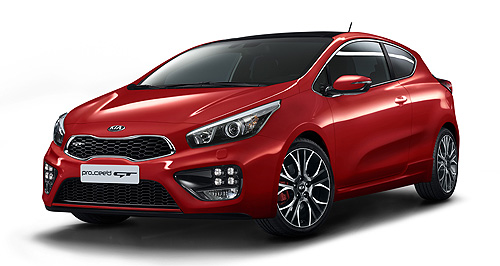Future models - KiaKiaSwapping cogs: A dual-clutch gearbox will allow Kia to squeeze more performance out of its engines. 8 Mar 2013 By BYRON MATHIOUDAKIS in GENEVA KIA has confirmed that a seven-speed dual-clutch automatic transmission is destined for a production vehicle in the next 12 months. Likely to be offered as an alternative to the six-speed manual gearbox just announced in the Pro_cee’d GT, the DCT gearbox, as it will be known, will also bring even higher power and torque outputs to the fledgling hot hatch. Kia’s DCT follows Hyundai’s own dual-clutch program first seen in the 2011 Veloster, but goes one better than its stablemate’s six-speeder unit – though that situation isn’t likely to last seeing the former company’s lead in the technology. While head of drivetrain engineering, Dr Joachim Hahn, confirmed the release of a Kia-equipped seven-speed DCT for 2014, he would not elaborate on which model would be first to feature it for production. The Geneva motor show-stealing Provo Concept is the Korean car-maker’s first vehicle to use this sort of gearbox. “We are not only developing a seven-speed dual-clutch transmission only for a show car,” he revealed to the Australian media at the Swiss press day event this week. “There is more behind it. We are well on the track of development. And we can promise that within the next year you will see the first application of that new seven-speed DCT in our vehicle… maybe even (in the GT car).” However, Kia will continue to offer more conventional torque-converter automatic transmissions – with ratios up to nine or even 10 speeds in the future – to meet the differing needs of consumers, especially in Asia and America, where drivetrain comfort and smoothness is valued very highly. “As a European I see how the dual-clutch can replace a torque converter … because especially of benefits in efficiency, and maybe because Europeans are not that sensitive in the comfort (issues of dual-clutch gearboxes),” Dr Hahn said. “But one challenge in comparison to the torque converter clearly is with take-off (smoothness) such as on hills or inclinations.” The Geneva debuting Cee’d GT and confirmed-for-Australia Pro_cee’d GT are both powered by the Hyundai/Kia group’s 1.6-litre direct-injection four-cylinder petrol engine, producing 150kW of power and 265Nm of torque, and driving the front wheels via a six-speed manual gearbox. However, thanks to the seven-speed dual-clutch gearbox, expect power and torque outputs to increase in the vicinity of 10 per cent, to total about 165kW and 300Nm respectively. “The idea is to combine the seven-speed transmission with a likely more powerful engine than we are currently doing in the six-speed clutch transmission (model),” Dr Hahn revealed. “So the range you mentioned before (10 to 15 per cent increase) for the Pro_cee’d GT is the range we are looking for.” However, despite entering into Volkswagen Golf GTI heartland with the output increases, Mr Hahn believes that the none of Kia’s fledgling hot hatch models planned for the near future would include a limited slip differential of either mechanical or electronic actuation for improved front-wheel traction. “In the development phase, of course, that was investigated,” he said. “And if we go further with the performance maybe that would be possible … with an LSD (limited slip differential) electronically. “But now we are convinced that the car is good without, so we don’t have the need for such a device.”  Read moreAll future models Alfa Romeo Alfa Romeo Abarth Abarth Audi Audi Aston Martin Aston Martin BMW BMW Bentley Bentley Chrysler Chrysler Chevrolet Chevrolet Dodge Dodge Citroen Citroen Ferrari Ferrari DS DS Ford Ford Fiat Fiat FPV FPV Foton Foton Haval Haval Great Wall Great Wall Honda Honda Holden Holden Hyundai Hyundai HSV HSV Isuzu Isuzu Infiniti Infiniti Jeep Jeep Jaguar Jaguar Lamborghini Lamborghini Kia Kia Lexus Lexus Land Rover Land Rover Mazda Mazda Maserati Maserati Mercedes-Benz Mercedes-Benz McLaren McLaren Mini Mini Nissan Nissan Mitsubishi Mitsubishi Peugeot Peugeot Opel Opel Proton Proton Porsche Porsche Renault Renault Ram Ram Saab Saab Rolls-Royce Rolls-Royce Smart Smart Skoda Skoda Subaru Subaru SsangYong SsangYong Tesla Tesla Suzuki Suzuki Toyota Toyota Volvo VolvoMotor industry news |
Click to shareKia modelsResearch Kia All future models Alfa Romeo Alfa Romeo Abarth Abarth Audi Audi Aston Martin Aston Martin BMW BMW Bentley Bentley Chrysler Chrysler Chevrolet Chevrolet Dodge Dodge Citroen Citroen Ferrari Ferrari DS DS Ford Ford Fiat Fiat FPV FPV Foton Foton Haval Haval Great Wall Great Wall Honda Honda Holden Holden Hyundai Hyundai HSV HSV Isuzu Isuzu Infiniti Infiniti Jeep Jeep Jaguar Jaguar Lamborghini Lamborghini Kia Kia Lexus Lexus Land Rover Land Rover Mazda Mazda Maserati Maserati Mercedes-Benz Mercedes-Benz McLaren McLaren Mini Mini Nissan Nissan Mitsubishi Mitsubishi Peugeot Peugeot Opel Opel Proton Proton Porsche Porsche Renault Renault Ram Ram Saab Saab Rolls-Royce Rolls-Royce Smart Smart Skoda Skoda Subaru Subaru SsangYong SsangYong Tesla Tesla Suzuki Suzuki Toyota Toyota Volvo VolvoMotor industry news |

















Facebook Twitter Instagram